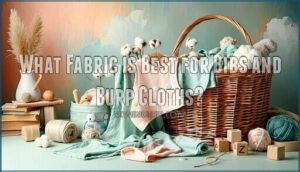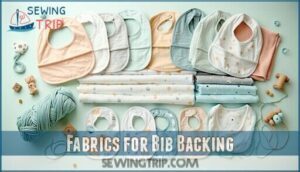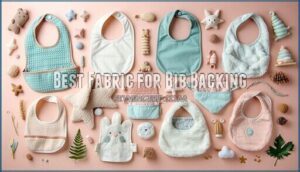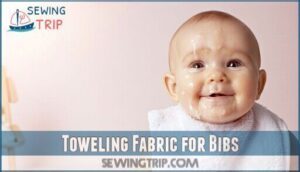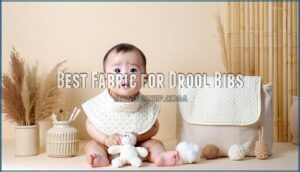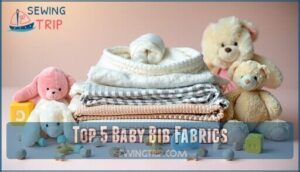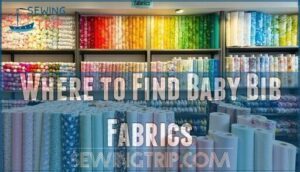This site is supported by our readers. We may earn a commission, at no cost to you, if you purchase through links.
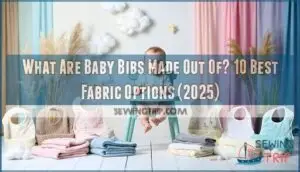
Cotton is the most popular choice – it’s soft, breathable, and machine-washable. You’ll also find flannel for extra warmth, terrycloth for superior absorption, and bamboo for naturally antimicrobial properties.
Waterproof options include polyurethane laminate (PUL) and silicone, perfect for messy eaters. Fleece varieties like polar fleece and microfleece offer cozy warmth, while minky fabric provides luxurious softness. Jersey knit stretches comfortably around baby’s neck.
Each fabric serves different needs – from everyday drool protection to full meal coverage. Understanding these materials helps you choose the right bib for every situation and stage of your little one’s development, considering factors like comfort, functionality, and the type of meal, to ensure you have the right protection for your baby.
Table Of Contents
- Key Takeaways
- What Are Baby Bibs Made Out Of?
- What Fabric is Best for Bibs and Burp Cloths?
- Fabrics for Bib Backing
- Best Fabric for Bib Backing
- Waterproof Fabric for Bibs
- Toweling Fabric for Bibs
- Best Fabric for Drool Bibs
- How Much Fabric for a Baby Bib?
- Top 5 Baby Bib Fabrics
- Where to Find Baby Bib Fabrics
- Frequently Asked Questions (FAQs)
- Conclusion
Key Takeaways
- You’ll want cotton for everyday use – it’s soft, absorbent, and machine-washable, making it the most popular choice for daily drooling and feeding situations.
- Choose waterproof materials for messy meals – PUL (polyurethane laminate) and silicone create effective barriers against spills while remaining breathable and comfortable.
- Consider bamboo for sensitive skin – it offers three times the moisture absorption of cotton plus natural antimicrobial and hypoallergenic properties.
- Match fabric to your baby’s needs – terrycloth excels for heavy droolers, fleece provides warmth for cold weather, and multi-layer combinations offer the best of both worlds.
What Are Baby Bibs Made Out Of?
Baby bibs are made from various fabrics designed to protect your little one’s clothes during feeding and drooling.
The most common materials include cotton, flannel, terrycloth, bamboo, and waterproof synthetics like PUL, each offering different levels of absorbency and comfort.
Cotton
You’ll find cotton bibs are your go-to choice for everyday messes.
This natural fiber offers excellent cotton absorbency while providing cotton softness against baby’s delicate skin.
Cotton durability means these bibs withstand frequent washing, and cotton care is simple—just toss them in the machine.
Cotton varieties like 100 cotton and cotton interlock provide different textures, with cotton fabrics available in countless prints to match any outfit.
Flannel
Flannel wraps your baby in cozy warmth while tackling everyday messes.
This soft fabric features a fuzzy texture that’s perfect for cold weather comfort.
Made from 100% cotton, flannel provides excellent absorbency and prevents soak-through better than basic cotton bibs.
The medium-weight construction creates a gentle barrier against spills while remaining breathable.
You’ll find flannel types ranging from lightweight to heavier winter bibs, all offering that signature soft feel babies love.
The fabric’s tight weave enhances its protective qualities, making it ideal for drooling toddlers.
Choose flannel when you want bib materials that combine comfort with reliable protection.
Terrycloth
Terrycloth stands out as the heavyweight champion of absorbent materials, soaking up to five times more liquid than cotton or flannel.
This looped fabric creates maximum surface area for capturing spills and drool effectively.
While terrycloth’s superior absorbency makes it ideal for heavy droolers, it can shed fibers initially and retains heat during warmer months.
Cotton blends offer softer alternatives with good absorbency.
With proper care, terrycloth maintains its fabric softness and remains a top choice for bib materials, providing good absorbency.
Bamboo
Bamboo fabric offers exceptional softness and breathability for your baby’s delicate skin.
This sustainable material provides natural antibacterial properties, making it an ecofriendly choice that’s hypoallergenic and moisture-wicking.
Bamboo velour, bamboo toweling, and bamboo interlock varieties deliver superior comfort while supporting environmental responsibility.
These natural fibers create gentle, long-lasting bibs perfect for sensitive skin, making bamboo a great choice for sustainable baby products.
Polyurethane Laminate (PUL)
Polyurethane laminate (PUL) stands as the gold standard for waterproof fabrics in baby bibs.
This synthetic material creates an impermeable barrier that keeps liquids from soaking through to baby’s clothes.
Here are five key PUL benefits for baby bibs:
- Complete waterproofing – blocks all liquid penetration
- Breathable barriers – allows air circulation while stopping moisture
- Machine washable – maintains waterproofing through repeated washing
- Lightweight construction – adds minimal bulk to bib design
- Durable performance – withstands daily use without degrading
PUL fabric excels in messy feeding situations where traditional materials fail.
Unlike laminated cotton alternatives, pure polyurethane laminate PUL offers superior waterproofing without compromising flexibility.
This synthetic material wipes clean easily and dries quickly between uses, making it ideal for busy parents who need reliable protection during mealtimes.
Polar Fleece
Choosing polar fleece for bibs brings warmth and comfort to your little one’s wardrobe.
This soft fabric offers excellent absorbency while providing cozy protection during colder months.
Polar fleece’s synthetic fibers resist moisture and dry quickly, making cleanup easier.
However, it can feel warm against baby’s skin during summer months.
The fabric’s durability withstands frequent washing while maintaining its softness and fleece benefits throughout extended use.
Microfleece
Microfleece’s lightweight nature makes it perfect for busy babies who need comfortable protection.
This soft fabric offers excellent absorbency without the bulk of regular fleece.
- Lightweight Options: Won’t weigh down active babies
- Breathable Materials: Prevents overheating during meals
- Soft Fabrics: Gentle against sensitive skin
- Absorbent Fabrics: Handles spills effectively
Minky Fabric
When you’re seeking the ultimate in plush comfort for your baby’s bibs, minky fabric delivers an unmatched luxurious feel that transforms ordinary feeding time into a cozy experience.
Key Benefits of Minky Fabric:
- Minky Softness: The plush fabric provides extraordinary comfort against your baby’s delicate skin, making it ideal for extended wear during feeding sessions.
- Fabric Care: Wash on gentle cycle with cold water and avoid high heat to preserve the fabric’s signature softness and prevent matting.
- Minky Durability: High-quality minky fabric withstands regular washing while maintaining its plush texture, though it requires proper care techniques.
- Design Versatility: Available in countless colors and patterns, minky fabric allows you to create stylish bibs that complement any outfit.
- Winter Comfort: The fabric’s warmth makes it perfect for cold-weather bibs, keeping babies comfortable during chilly feeding times.
Consider cuddlesoft as a budget-friendly alternative that offers similar soft fabrics benefits without the premium price point.
Jersey Knit
Jersey knit fabric offers exceptional comfort for baby bibs thanks to its unique stretchy properties. This knit fabric care requires simple machine washing, making it parent-friendly for daily use.
When comparing softness, jersey knit rivals cotton while providing superior stretch. The fabric’s breathability factors make it ideal for active babies who need airflow against their skin.
Unlike rigid materials, jersey knit moves with your baby’s movements without restricting comfort. Durability tests show jersey knit maintains its shape after repeated washing cycles.
The fabric properties include natural stretch recovery, meaning bibs won’t lose their fit over time. This absorbent material effectively catches drool and spills while remaining gentle on sensitive skin.
Jersey knit’s breathable nature prevents overheating during extended wear. Parents appreciate how this fabric combines functionality with comfort – it’s soft enough for newborns yet durable enough for toddlers.
The natural give in the fabric creates a perfect fit without tight binding around the neck area. When selecting fabrics for baby items, considering baby fabric options is essential for ensuring the comfort and safety of the child.
Quilt-Light Polyester Batting
While jersey knit handles daily wear, quilt-light polyester batting brings extra comfort to baby bibs.
This polyester fill material adds gentle cushioning between fabric layers without bulk.
You’ll find this batting creates soft, puffy bibs perfect for extended wear.
Here’s what makes polyester batting shine:
- Lightweight insulation – Adds warmth without weight
- Tear-resistant durability – Withstands frequent washing cycles
- Easy quilting finish – Glazene coating prevents shifting during sewing
- Consistent thermal properties – Maintains loft after multiple washes
This quilt material works best as a middle layer between cotton front and waterproof backing.
The fabric insulation keeps babies comfortable while providing extra absorption for heavy droolers.
What Fabric is Best for Bibs and Burp Cloths?
Cotton and bamboo lead fabric options for bibs and burp cloths.
Cotton offers excellent absorbency and easy washing, while bamboo provides three times the moisture absorption plus hypoallergenic properties.
For waterproof bibs, PUL creates an effective barrier.
Silicone bibs wipe clean easily but lack absorbent layers.
Cloth selection depends on your priorities: cotton for budget-friendliness, bamboo for sensitive skin, or layered textile choices combining materials.
Absorbency tests show bamboo outperforms cotton, making it ideal for heavy droolers despite higher costs.
Parents can explore eco friendly options to make informed decisions about their baby’s clothing and accessories, considering hypoallergenic properties and moisture absorption.
Fabrics for Bib Backing
You’ll need bib backing that works as hard as your little one plays.
PUL Fabric leads the pack for waterproof bibs, creating an unbreakable barrier against spills while staying breathable.
Minky Backing offers luxurious softness that babies love, though it’s less waterproof than PUL.
Fleece Layers provide warmth and moderate protection, perfect for winter feeding sessions.
Cotton Backings deliver reliable absorbency and easy washing.
Microfleece Options give you the sweet spot between comfort and protection.
Consider your fabric requirements carefully – waterproof protection versus soft comfort shapes your choice.
When choosing the right fabric, understanding lining fabric types is vital for superior performance and durability.
Best Fabric for Bib Backing
The right bib backing transforms messy mealtimes into manageable moments.
Your choice depends on your baby’s needs and your lifestyle preferences.
PUL Fabric stands out as the top waterproof option, offering excellent breathability and durability.
Microfleece Layer provides gentle absorption without bulk, while Cuddlesoft Backing delivers softness at an affordable price.
Minky Liner adds luxurious comfort but requires more maintenance.
Fleece Barrier offers budget-friendly protection with vibrant design options.
Consider these key factors when selecting your bib backing:
- Absorbency – Terrycloth and bamboo excel at soaking up spills and drool
- Waterproofing – PUL creates an effective barrier against liquid penetration
- Breathability – Look for fabrics that allow air circulation to prevent overheating
- Skin sensitivity – Choose hypoallergenic materials like bamboo for delicate skin
- Maintenance – Select easy-care fabrics that withstand frequent washing
Match your fabric requirements to your baby’s feeding stage and sensitivity level.
Waterproof Fabric for Bibs
Protecting your baby’s clothes from spills becomes effortless when you choose the right waterproof materials. PUL fabric leads the pack with its synthetic blend of polyester and polyurethane, creating a breathable yet moisture-wicking barrier that’s gentle against delicate skin.
Unlike traditional vinyl, PUL maintains flexibility while blocking liquids completely. ECOPUL offers an eco-friendly twist on waterproof technology, combining environmental consciousness with practical protection.
These synthetic fabrics excel as bib linings, preventing messy meals from reaching clothes underneath. The absorbent face layer works with waterproof backing to create the perfect moisture-wicking system that keeps babies comfortable during feeding time.
Parents can find effective waterproof bib solutions to prevent dribble rash and dry skin around the mouth.
Toweling Fabric for Bibs
While waterproof materials protect against spills, toweling fabric excels at absorbing moisture before it reaches your baby’s clothes.
Terry cloth stands out as the gold standard for absorbent materials due to its looped construction.
Here’s why toweling fabric works so well for bibs:
- Superior absorbency – bamboo toweling can absorb three times its weight in liquid
- Fabric softness – becomes softer with each wash, gentle on delicate skin
- Moisture wicking – pulls drool away from baby’s neck and chest quickly
Towel fabric creates excellent bib linings when paired with cotton fronts.
The terry cloth loops trap liquids effectively, preventing breakthrough.
This bib fabric combination offers both comfort and functionality for active babies.
The choice of fabric is vital, considering the best fabrics for superior absorbency and comfort.
Best Fabric for Drool Bibs
When selecting fabrics for drool bibs, cotton reigns supreme for its unbeatable combination of drool absorbency and fabric softness.
Cotton’s natural fibers create breathable materials that keep babies comfortable while effectively managing moisture.
Here are the top fabric choices for drool bibs:
- Cotton and bamboo – Natural eco friendly options with superior moisture wicking properties and hypoallergenic benefits
- Terrycloth layers – Absorbent layers with looped fibers that trap drool effectively while maintaining softness against skin
- Multi-layer construction – Combining cotton tops with waterproof layers like PUL creates ideal protection without sacrificing breathability
Unlike silicone bibs that can feel cold and rigid, fabric bibs provide the perfect balance of absorption and comfort for all-day wear.
How Much Fabric for a Baby Bib?
Planning your fabric purchase correctly saves time and prevents waste. Most standard baby bibs require approximately 1/4 to 1/2 yard of fabric, depending on your specific needs.
Here’s what determines your fabric requirements:
- Bib Sizing and Pattern Making: Standard bibs measure 8-12 inches wide by 10-14 inches long, while larger feeding bibs need more material for extended coverage.
- Material Thickness and Fabric Dimensions: Thicker fabrics like terrycloth require precise sewing measurements, while thinner materials like cotton allow closer pattern placement on your fabric yardage.
- Fabric Selection Strategy: Multi-layer bibs combining different bib fabric types need separate calculations for each layer, plus seam allowances for proper construction.
Most fabric stores sell by the yard, and you’ll find that 1/2 yard comfortably accommodates 2-3 standard bibs with room for mistakes. Always buy slightly more than calculated to account for pattern matching and potential do-overs.
Top 5 Baby Bib Fabrics
After understanding fabric quantities, you’ll want to focus on the top performers. These five bib materials offer the best combination of functionality and comfort for your baby’s needs.
| Fabric | Best Feature | Ideal For |
|---|---|---|
| Cotton | Superior absorbency and softness | Daily drooling and feeding |
| Bamboo | Hypoallergenic and eco friendly properties | Sensitive skin babies |
| Fleece | Excellent bib durability and warmth | Cold weather protection |
| PUL | Waterproof barrier with breathable fabrics | Messy eaters and spills |
| Terrycloth | Maximum liquid absorption | Heavy droolers and teething |
Cotton remains the gold standard for fabric softness and breathability. Bamboo offers natural antimicrobial benefits while staying gentle on delicate skin. Fleece provides cozy warmth during winter months. PUL delivers unmatched spill protection without compromising comfort. Terrycloth handles the messiest situations with superior absorption power.
When selecting the perfect bib, consider the importance of baby bib fabrics to guarantee the best results for your baby’s comfort and hygiene.
Where to Find Baby Bib Fabrics
You’ll find baby bib fabrics at fabric stores like JoAnn’s, which stocks cotton, flannel, and PUL options specifically for nursery projects.
Online markets such as Amazon and Etsy offer extensive selections including bamboo and specialty waterproof materials.
Craft shops typically carry basic cotton and terry cloth varieties.
Wholesale websites like Wazoodle Fabrics provide specialized baby bib fabric options including all-in-one solutions.
Local sellers at thrift stores offer unique prints for creative projects, while Spoonflower enables custom fabric printing for personalized designs.
When choosing fabrics, consider the importance of absorbent fabric options to guarantee the bibs are both functional and comfortable.
Frequently Asked Questions (FAQs)
Which fabric is suitable for making baby bibs?
Cotton stands out as the top choice for baby bibs.
You’ll find it’s soft, absorbent, and machine-washable.
Flannel, terrycloth, and bamboo also work well, offering excellent absorption and gentleness against your baby’s delicate skin, making them a good alternative to cotton, which is also very absorbent.
What is a good bib fabric?
You’ll find cotton tops the list for baby bibs due to its softness, absorbency, and easy washing.
Flannel offers extra absorption, while bamboo provides hypoallergenic properties.
For waterproofing, choose PUL backing.
What is a feeding bib made of?
Feeding bibs are typically made from waterproof materials like silicone, plastic, or PUL (polyurethane laminate), combined with absorbent fabrics such as cotton or terrycloth for comfort and spill protection.
What are the best materials for baby bibs & Burp cloths?
Studies show babies drool up to 2 teaspoons daily during teething peaks.
You’ll want 100% cotton or bamboo fabric for the front layer—both are soft, absorbent, and hypoallergenic.
For backing, choose PUL (polyurethane laminate) for waterproof protection or terrycloth for maximum absorption.
What is a feeding bib?
A feeding bib is a protective garment designed to catch spills and messes during mealtime.
You’ll find they’re made from easy-to-clean materials like waterproof synthetics or wipeable fabrics, featuring adjustable closures for a secure fit.
Why do babies need a feeding bib?
Like a superhero’s shield protecting their outfit, feeding bibs save your baby’s clothes from spills and messes during mealtime.
They’re essential because babies haven’t developed the motor skills to eat neatly, making bibs your best defense against stains and constant outfit changes, acting as your best defense.
What material is used for baby bibs?
Baby bibs are commonly made from cotton, bamboo, terrycloth, and flannel for absorbency. You’ll also find waterproof options using PUL (polyurethane laminate) or silicone for easy cleanup during messy meals.
What fabric is used to make waterproof bibs?
Waterproof bibs typically use polyurethane laminate (PUL), which creates a breathable yet spill-resistant barrier.
You’ll also find thermoplastic polyurethane (TPU), laminated cotton, and coated fabrics that keep moisture from soaking through to clothes.
What type of bibs are best for babies?
Cotton bibs work best for everyday drooling, while waterproof PUL-backed bibs excel during feeding time.
You’ll want soft, absorbent fabrics like bamboo or terrycloth that won’t irritate delicate skin yet handle spills effectively.
How do you wash baby bibs safely?
Wash baby bibs immediately after each use in warm water with gentle, fragrance-free detergent.
Pre-treat stains with cold water.
Machine wash cotton and bamboo bibs on gentle cycle, air dry when possible to preserve absorbency and prevent shrinking.
Conclusion
Choosing the right bib material is absolutely vital for your baby’s comfort and your sanity during feeding time.
Now that you understand what baby bibs are made out of, you can make informed decisions based on your specific needs.
Cotton works well for everyday drool, while waterproof options like PUL handle messy meals.
Consider your baby’s age, feeding habits, and comfort preferences when selecting materials, and having multiple fabric types guarantees you’re prepared for every feeding situation, which is crucial for your sanity.
- https://merchone.com/apparel/baby-bib/
- https://www.halosleep.com/blogs/aden/baby-bibs-a-complete-guide
- https://happymattystore.com/blogs/news/eco-friendly-pineapple-print-baby-bibs-sustainable-choices-for-modern-parents
- https://gladlyfamily.com/products/6-piece-bib-set
- https://www.nestdesigns.com/blogs/clothing/what-are-the-types-of-baby-bibs-and-which-ones-do-you-need

